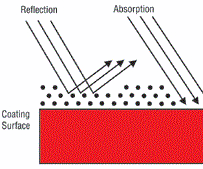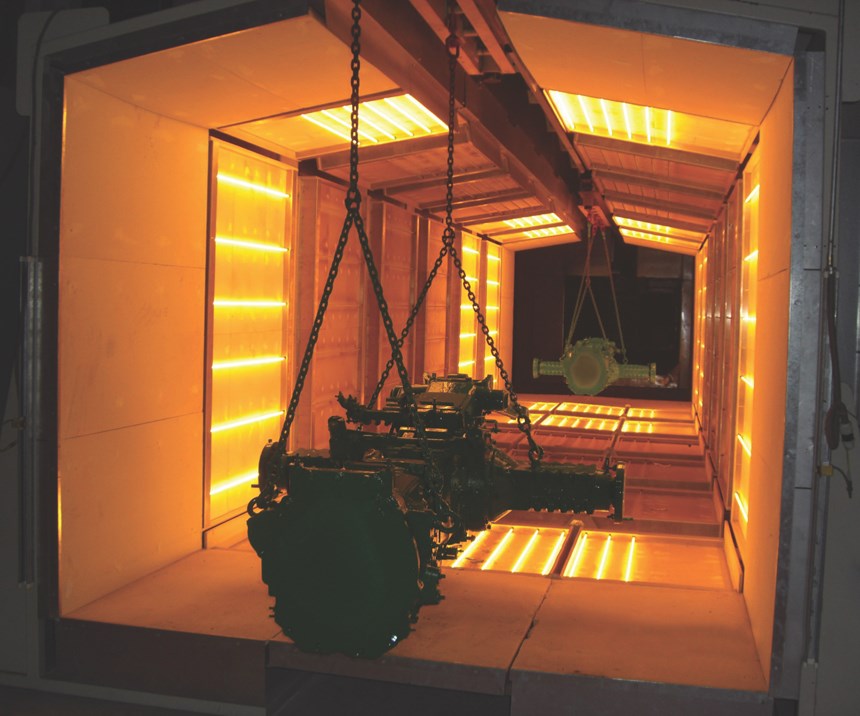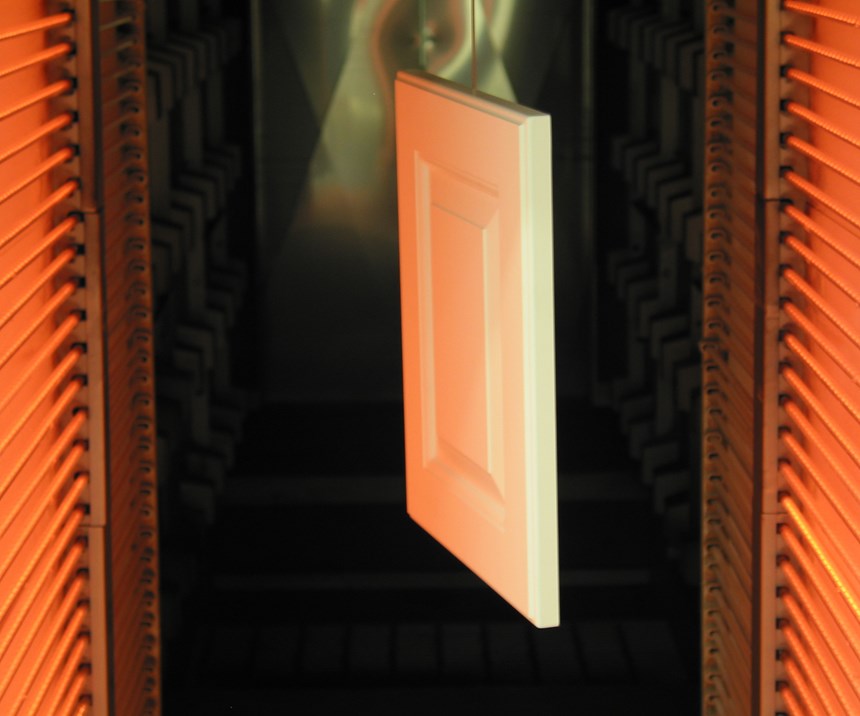Infrared curing works well with powder coating applications and is also excellent for a liquid paint line, whether it’s single-component, 2- or 3- components, water/solvent-based or other type of coating.
Frank Villella, who runs BGK Infrared Lab and is one of the most knowledgeable people on infrared radiation (IR) in the business, says that the reason IR gets utilized for powder coatings so often is because it’s a no-brainer for powder as it’s less risky and easy to test.
Featured Content
“With liquid coatings, you have to be careful as to wet film thickness and the type of solvents or water-based used in the coatings,” he says. “IR is great on most liquid coatings. The testing of IR on liquid coatings is much more involved and requires testing to determine what is needed. Powder is not nearly as involved.”
IR ovens provide a faster and complete cure on most products and coatings, and liquid coatings are no exception. The speed controls enable customers to save time and energy, and achieve improved quality.
Infrared has been around for many years, but the newer electronic controls, programmable logic controllers (PLCs), optical pyrometers and ease of programming ease for zoning and IR heat intensity have made it vastly better and even superior to some ovens on certain applications.
Getting a quicker cure or dry time is usually the reason most applicators ask about IR. Sometimes they require increased production, which often means they need a faster line speed. Other times, it’s due to a new coating chosen by a customer that comes with a longer cure time — which can be an issue for production, but is critical to the product coating’s durability. Or it’s just a water-based coating that is slow to flash and cure.
IR ovens are often twice as fast, if not 3-4 times faster (60-90% less curing time), plus there is also the ease of installation. An added bonus is an extremely precise temperature control, as IR enables putting heat on the exact spot, which is important.
In the finishing process, there are usually two common types of curing — convection and IR. Ultraviolet and conduction are also used, but we’ll just compare convection and IR here.
Curing Liquid or Powder on Wood Substrates
Convection Ovens: Why are convection ovens the most common? The answer is because they are safe and thorough. They are not cheap, but could still be a lower initial investment. However, they are very slow when compared to IR. A good convection oven can be much quicker if proper airflow and air distribution is actually part of the design. A convection oven with bad airflow can be a problem resulting in incomplete cure (hot spots/cold spots) and a very long cure time. When we speak of safe for curing, we are talking about not overheating the product during the curing process. A convection oven tends to soak the heat into the part. There is a way around this issue, but it is very expensive. Convection is safe because it is tough to burn a coating if you have the temperatures under control. A product with heavy gauge steel or structural steel components next to thin gauge metals has different cure times over the product length and height. With convection heat, the oven is set for the air temperature to get the substrate temperature to the cure temperature. So, if a part temperature needs to get to 200°F, the oven is set at 225°F for 15 minutes. Regardless of what happens (such as a conveyor stop), the product will never get hotter than 225°F. However, with IR that is not true. Until the heavier section of the product reaches temperature, the product remains in the oven.
Infrared Ovens: IR cures by using short, medium and long wavelengths. Each wavelength will work on any coating, but it is the exposure time that needs to be determined to achieve a full cure. Matching the best IR wavelength to the coating type or color helps improve speed and completion of cure. There are numerous benefits to IR, including the ability to be shaped and sized for better heating. If parts are batched by size, then IR ovens can be widened or narrowed automatically to bring IR emitters closer to the part surface. Why would this matter? It keeps emitters close to the part and saves energy as the emitters don’t have to be turned up in temperature as narrow parts pass through a wide oven. IR ovens are also easy to zone from top to middle to bottom, and there is little to no airflow needed. That means no dirt or contamination is blown onto parts and no large blowers are needed. If a particular product-and-paint combination is tough to cure or you are trying to cure faster, then keep the IR emitters on high and use the recirculated air to cool the product surface. It’s kind of like using the gas pedal and brake at the same time. In everyday driving we wouldn’t do it, but in a race we do. Time is money, so we are in a race to get the paint cured.
Sizing the Oven Correctly
Oven size is also very important. For convection ovens, the example we will use is 10 feet per minute (FPM) conveyor line speed and a cure time of 15 minutes, which equals 150 feet of conveyor in any configuration. If you add a 10-minute cooldown, that adds another 100 feet of conveyor travel. With liquid coatings, curing typically requires a lower temperature and less time than a powder coating.
IR is much quicker, but the actual time savings can’t be quantified until the coating is on the product and tested. However, I have never seen IR fail to speed up drying or curing times. There are also time variations due to coatings, part configuration and product conveyance. So, in the above example at 10 FPM times two minutes of IR plus four minutes of hold (letting part remain at temperature), that equals a completed cure of 60 feet of conveyor. Then cooling is needed to complete the cure, which means five more minutes at 50 feet for a total of 110 feet compared to 250 feet, which means IR results in a 56% reduction in curing time.
The biggest difference in IR from years past is the improvement in oven controls. PLCs have become better and less expensive, and pyrometers can provide temperature verifications throughout the oven cure cycle, or can provide closed loop temperature control. Closed loop means that the pyrometers can look at a specific area on a part in the oven and can then increase or decrease the temperature on the entire part or a specific section of a part without any human interaction.
Remember, parts need to cool for the coating to harden and also be cool enough to handle without parts sticking to each other if they are stacked or packed.
The option of curing 75% faster with ultimate control should make any applicator give IR ovens serious consideration.
Marty Powell is a technical systems specialist at Carlisle Fluid Technologies.
RELATED CONTENT
-
Is Your Electroplating Waste Hazardous?
Some that bears precious metals is, and there are a host of regulations to consider when recycling.
-
Phosphate Conversion Coatings
Types of phosphate conversion coatings, how to apply them, and their specific functions.
-
Coating Thickness Measurement: The Fundamentals
A review of available test methods, common applications and innovative instrumentation...
























